Many paid attention to the first spring flowers, which just fascinate. Together with tulips, hyacinths are one of the first to delight us with their bright flowering and fragrant aroma.
Content |
Hyacinths are universal flowers that can be grown in the open ground, at home and use for cutting. All these flowers differ simply delightful buds that have the most diverse color. Want to become the owner of the brightest and colorful spring garden - then hyacinths, landing and care for which will not be difficult for even novice gardeners, it is those flowers that you need.
In this article, we will consider the features of hyacinths, the most popular species and varieties of hyacinths, as well as tell about the main nuances of agrotechnology of cultivation.
Features, History of Origin and Description of Hyacinth
Hyacinth is one of the first decorative flowering plants that blooms simultaneously with tulips. He was and remains a favorite garden flower, which attracts attention to its unusual structure of inflorescences and an incredible aroma.
Holy hyacinths are Eastern Asia, the Northern part of Africa and the Mediterranean, in particular Greece. In these territories, a beautiful hyacinth flower begins his bloom during the warm rain. It is the time of flowering that was the name of this flower, because translated from Greek hyacinth is a "rain flower".
However, today, the real home of hyacinth can be called Holland. It is here, in the homeland of tulips, a huge number of hyacinths is grown annually, and their bulbs are supplied at all corners of the world. Therefore, the Netherlands can be considered the second homeland of this beautiful flower. For the first time, they became in Europe for the first time in the 15th century, after which they quickly spread around the world. It is worth noting that most types and varieties of hyacinths were launched in Holland.
The story of the appearance of these colors takes us right in ancient Greece in the times of the gods. One of the legends says that during sports contest, Apollo in a ridiculous accident killed the royal son of Hiacinte. Blood drops, fallen on the grass, turned into beautiful scarlet flowers, which were called "hyacinths".
Description of hyacinths:
- Hyacinth is a bulk perennial plant, which belongs to the Lily family.
- The bulbs of the hyacinth of small size, consist of juicy lower leaves.
- The first of the Earth there is a stem with small fractures of flowers, and then the oblong leaves are already beginning to be revealed.
- Hyacinth leaves are sufficient fleshy and have the right elongated shape of a bright green color. Length can reach 9-12 cm.
- In the center of a peculiar funnel is shown inflorescence covered with buds. The length of this stem on average is 30 cm.
- This stem after flowering dry out with the leaves.
- After drying out in the corner of the upper sheet, the kidney is formed, which will later become a bulb. It is used to continue flowering next year. Multiple kidneys are also formed, which can be used to reproduce hyacinth.
- The hyacinth flower is a cruise inflorescence, which is located on the top of the stem. In diameter it can reach 10 cm. These inflorescences have the form of a cylinder or a cone.
- Flowers are in the inflorescences tight enough and have different sizes, the average value is 1-2 cm. In one inflorescence, it can be from 15 to 25 pieces, less often 50.
- The perianth is a brightly painted funnel in the form of a bell, from which bent petals depart. These petals can often be slightly twisted.
- Color coloring of hyacinths is very diverse. You can find white, pink flowers, as well as blue and even black.
- The period of flowering hyacinths accounts for approximately the end of April-beginning of May and lasts 7 days. Some varieties of hyacinths can bloom for 15 days.
- The fruit of hyacinths is a small box, divided into three sockets. In each nest is two seeds.
The main types and varieties of hyacinths
To date, about 30 types of hyacinths are known, three of which grow in North Africa, and for the rest of the birthplace is the Mediterranean and East Asia. The most common view is the East hyacinth, which became the basis for the elimination of most decorative varieties of hyacinths. Let us consider in more detail the main types of hyacinths and the classification of their varieties.
Types of hyacinths
- Eastern hyacinth. The most numerous and common type of hyacinths. The habitat of this flower in nature is located in Croatia, Greece, Turkey, Lebanon, Syria. This type includes hyacinths that are perennial bulbous plants. Usually, 40 cm is achieved in the height. Coloring of inflorescence is very diverse: white flowers, pink, blue, blue, yellow. Blossom starts at the beginning of May and on average lasts 1-2 weeks. It is this kind of hyacinth, it is also called Dutch, has become a progenitor for all known decorative varieties.
- Water hyacinth. This type of hyacinth is also called Eukhorenia. The name "Water Hyacinth" indicates that these flowers grow in water and very love moisture. The optimal growth environment is swamps, lakes, ponds. In nature, this type of hyacinth is distributed in Brazil and other countries of South America, where the elevated level of humidity. These are pretty high flowers, which can be in height to reach 50 cm. A feature of such hyacinths are their inflorescences that have a delicate purple tint.
- Hyacinth Custinian. The name of this species speaks by itself for itself - the territory of the growth of these hyacinths is mainly in Turkmenistan. This is a very rare species, heights only 20 cm. It is highlighted by beautiful celestial flowers - the shade of their blue blue.
- Mouse hyacinth. This type of hyacinth is very common in Europe and Asia, as well as in Australia and Africa. Mouse hyacinms are characteristic of a large variety of colors, from white to bright pink and sky blue. They are distinguished by a very small growth, in the height of everything they reach 10-15 cm, but these hyacinths will be happy to delight their flowering. On average, hyacinth flowers for 15-20 days.
- Hyacinth Litvinova. The habitat of this type of hyacinth is located in Asia and North Africa, in particular in Lebanon, Syria and Turkey. These flowers simply fascinate with their unusual shades of inflorescences. You can find a bright bluish-green or saturated lilac.
Giacintov varieties
There are several classifications of hyacinth varieties. At one of them, hyacinths are distributed in flowering timing: Rannetic, medniving, lately flowering. You can also note the classification in the structure of the inflorescences of hyacinths: simple, terry and multi-flowered. However, the most common classification is based on the color range of hyacinth inflorescences:
- Pink hyacinths. They are distinguished by fine inflorescence. Of the most popular varieties of pink hyacinths, the following can be distinguished. Fondant - 25 cm are achieved in height, they differ in fairly large flowers of gentle pink. Edison - Can grow on 23 cm, flowers smaller pink. Anna Marie. - reaches 24 cm in height, flowers of bright pink color. Pink Pearl - This is an early grade, bright pink flowers with dark streak.
- White hyacinths. Such hyacinths have white or cream color of inflorescences. Edelweiss - Large inflorescences of snow-white color, height reaches 24 cm, is an early variety. Renssensen rental - Also early grade, white flowers, which gradually goes into cream. Snow Crystal - terry inflorescences, late grade, which blooms for 3 weeks.
- Blue or blue hyacinths. Prince Arthur - Blue shade inflorescences, a very high plant, in height reaches 30 cm. Maria - Height reaches 25 cm, bright blue inflorescences with white streaks.
- Red or crimson hyacinths. Woodstock - Differs in large purple-purple flowers. Jan Boss - Early grade of hyacinths, which blooms with red inflorescences with white streaks.
Methods of reproduction of hyacinths
Hyacinths multiply in several ways. You can breed these beautiful flowers using seeds and vegetatively.
Reproduction of seeds
This method is used very rarely. Most often, it is used by breeders for breeding new varieties of hyacinths. For the home cultivation of hyacinths, this method is not suitable, as it will have to wait for the first flowering for a very long time. This will happen not earlier than in 5-7 years. If you still decided to try to grow hyacinth in this way, then seed seeds are necessary in October in the prepared soil. Then, for 2 years, the plants germinate in a closed greenhouse.
Greeting of bulbs
This method is the most common and efficient. It is possible to highlight natural reproduction of bulbs and artificial reproduction. Let us consider here you consider each of these ways.
- Natural reproduction of bulbs. This method of reproduction of hyacinths is quite slow. Depending on the specific grade, an adult bulb for a year can form 1-3 small, less often. After complete flow of inflorescences and leaf drying, the bulbs are digging. This happens in about June, it is not necessary to dig up before. During this time, the adult bulb will strengthen and increase. Babies that are freely separated, planted separately. The bulbs, which are still tightly held for the maternal, do not touch, and the next year planted together with an adult bulb.
- Artificial reproduction of bulbs. It was the Dutch breeders who began to stimulate the appearance of small bulbs. This was helped by mice that cried the adult bulb. After that, the kids appeared rather quickly. Since then, many breeders and gardeners use artificial methods, such as cutting and cutting of the Donets, for the reproduction of hyacinths. Of course, after using this method, the adult bulb begins to rot and die with time. Dont cutting method - On a healthy bulb, you wedged with a donation along with the kidney and put the bulb under the film. Dont cutting method - cuts on a healthy bulb are made, after which the bulb is also placed for several months under the film for germination.
Preparation before landing
For beautiful spring colors, it is necessary to prepare carefully before they are planted. To do this, you need to choose and prepare the planting material, pick up a good plot and process the soil.
Selection and preparation of bulbs
The most important stage is the choice of high-quality planting material. Buy bulbs are best in specialized stores or nurseries. Do not take them to acquire from strangers in the markets or by the road. When buying bulbs, pay attention to their appearance. The main thing is that the bulbs of hyacinths are medium in size, since the cultivation of hyacinths from large bulbs may not lead to flowering. All bulbs should be strong, dense and healthy. There should be no damage. The bulb itself is desirable to be 1.5 times more in diameter than the Donets.
Choosing a place
These flowers are very demanding to the landing site. Hyacinths in the open soil should be located in a sunny place, which will be protected from strong winds. Some gardeners recommend landing these flowers into a slightly pronted plots, so you can extend their flowering. However, it should be remembered that large plants in the neighborhood can deprive nutrient hyacinths. Remember that hyacinths do not like close-to-go ground and excess moisture. It will be optimal to plant hyacinths on a small elevation.
The choice and preparation of the soil
Hyacintes are also very demanding of the soil. It should be loose and lightweight, saturated nutrients. The soil acidity is preferred neutral or weakly alkaline. If the acidity is improved on the selected area, it is necessary to process it - add some wood ash or lime to the soil.
Prepare the ground for landing hyacinths must be in advance. Usually this procedure is carried out in the summer so that the land has time to settle for the fall. Be sure to switch the soil well, about 40-50 cm. It is also important to support the land. To do this, you can add humid, potash salt or universal fertilizers. The beds can be covered with a film so that the soil quality does not spoil weeds.
When planting hyacinths
The recommended time for landing hyacinths to open ground is autumn, or rather the end of September-beginning of October. It is this period that is optimal to suit bulbs. If you put them before, the bulbs can be strongly rooted and let the sprouts, which will lead to their freezing in the winter. Too late landing is also harmful, the bulbs may suffer from winter frosts.
The process of landing hyacinths in open ground
In September-October, you can proceed to landing hyacinths:
- First of all, it is necessary to treat bulbs. For this, they are lowered into a solution of any fungicide for 30 minutes. Then get and dried.
- Next, it is necessary to dig up the planting wells for bulbs. The size of the well should be three times more than the sizes of the bulbs. Approximately 15-18 cm.
- Between the bulbs there must be a distance of 20 cm if they are large. For smaller, this distance is 10 cm.
- On the bottom of the wells you can pour a clean coarse sand with a layer of 3-5 cm to create drainage. Also, sand can be placed on the sides of the bulbs. It will save the planting material from excess moisture and infection with various infections.
- If during the preparation of the soil you did not make fertilizers, they can be added directly to the landing wells.
- The bulbs are inserted into the wells and the soil is added.
- After landing, the bulbs can be slightly pouring and inspired. The mulch uses a dry peat, sawdust or foliage.
- Peat or sawdust can be covered by the bulbs for the winter, and in the spring it all is neatly removed.
Features of the care of hyacinths in the open soil
Hyacinth care will not require any incredible efforts from you, but some nuances should be known and take into account.
Watering
After planting hyacinths, they should not water them. The exception is arid autumn, during which the flowers need to water, since the bulbs may not take care. In the future, the spring hyacinths are watered as needed, since these flowers require moderate watering. On average, the land around the colors should moisturize 15-20 cm. Two weeks after flowering, watering stops so that the bulbs do not accumulate too much moisture and did not rot.
Loosening and mulching
Periodically, the soil around the colors should be loosened and cleaned from weeds. During the weeding, you can delete faded inflorescences. Also, the plants can be added to the mulch to reduce the number of weeds and save moisture for longer. The mulch is used peat or sawdust.
Podchar
In total, during the growth of hyacinths, they can be filled with 2-3 times. For the first time, a solution of superphosphate is introduced into the soil during the start of the growth of hyacinths. The second time is fed during the appearance of buds. In this case, you need to add a solution of potassium and superphosphate into the soil. The 3rd feeder is carried out at the very end of flowering, in the process of which the solution of superphosphate and potassium is made.
Digging and storage of bulbs
The bulbs cannot be left to winter in the open soil, otherwise the next year they will bloom weakly. The time when hyacinths are digging is determined by the climatic zone. On average, this should happen at the end of June or in early July.
Many gardeners, first planted hyacinths, often arises the question of "Hyacinths beat, what to do next with them?" Everything is simple, at the beginning you need to wait until the hyacinths are swing and shake. After that, you can proceed to digging them. The bulbs need to be cleaned from the ground, old roots and top scales. More adult kids are disconnected, and smaller remains on an adult bulb.
To get beautiful blooming plants for the next year, it is important to store them correctly:
- Immediately after digging, the bulbs are dried under a canopy at a temperature of 20 degrees, as they are very demanding to heat.
- Next, the bulbs are sorted in size and stored two months at a temperature of 25-26 degrees.
- The next stage lasts a month and is predicted. The air temperature at this stage should be 17 degrees.
- It is also necessary to monitor the level of humidity.
Fighting pests and diseases
Any plant disease is easier to prevent than treated. Therefore, it is necessary to follow all rules for the care of the hyacinth during the cultivation of hyacinths, do not pour and keep the bulbs correctly. Hyacinths are very rarely affected by pests, and only yellow bacterial rotes can be noted from diseases. This disease is manifested by rotting bulbs. They turn into a mucus with a sharp odor. In this case, the bulbs are digging and removed, and the soil is treated with fungicides.
Photo of hyacinths in landscape design
Hyacintes are able to decorate any plot. In the proposed photos, you can see all the beauty and uniqueness of these colors.
Separate fellows with hyacinths
Hyacinths in combination with other colors
Spring flowers are the most desirable and beautiful messengers of the approaching heat. Therefore, in almost any garden, you can find early tulips, daffodils and hyacinths. If you want to get a bright spring garden or a flower garden, then the hyacinths are suitable for you best.


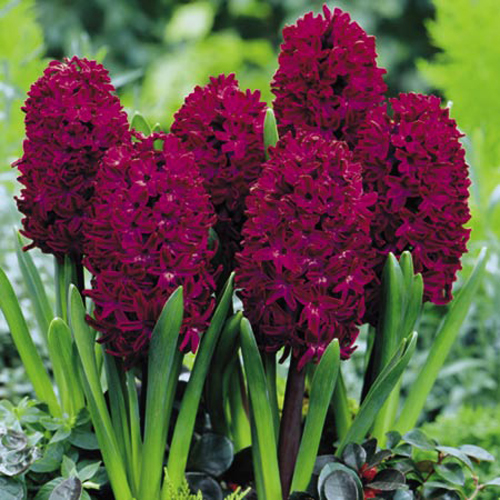

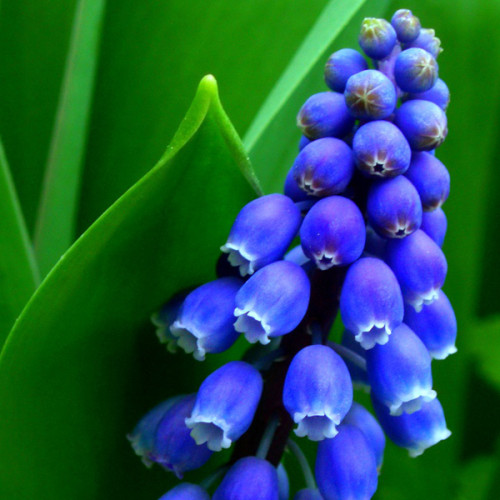
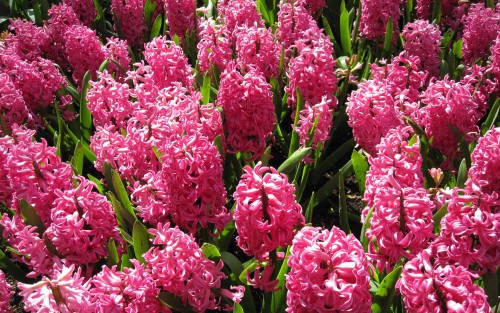
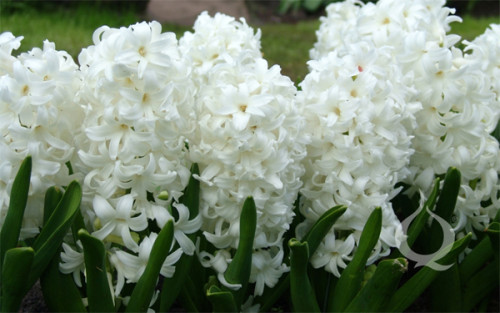
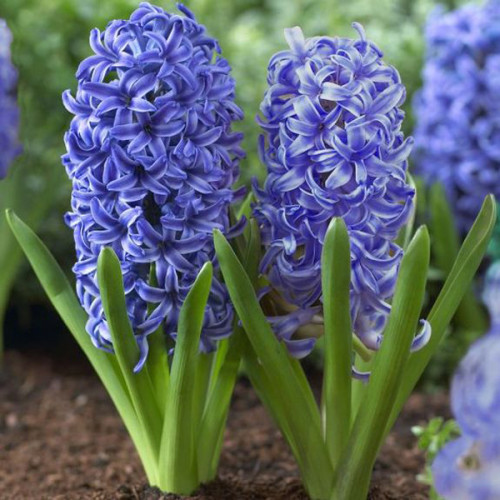
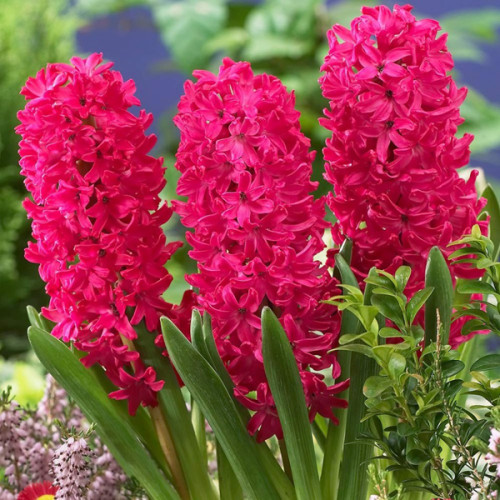
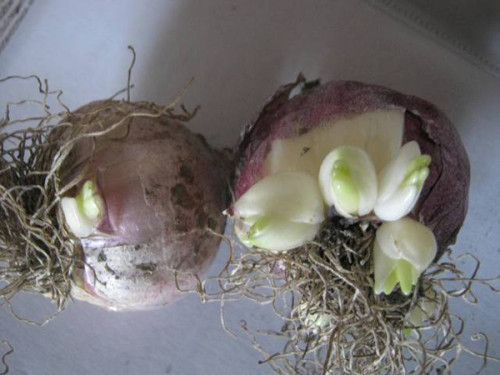
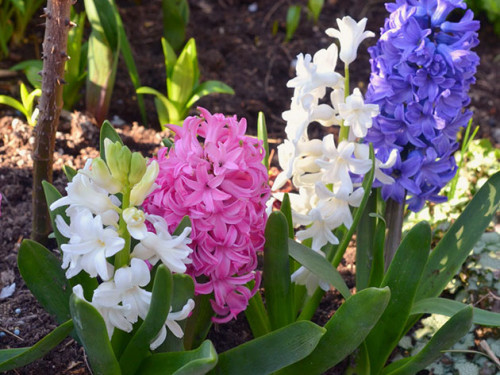
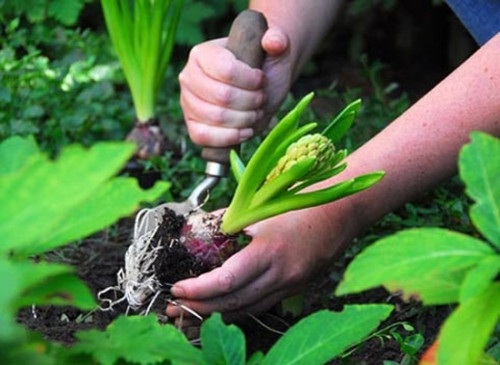
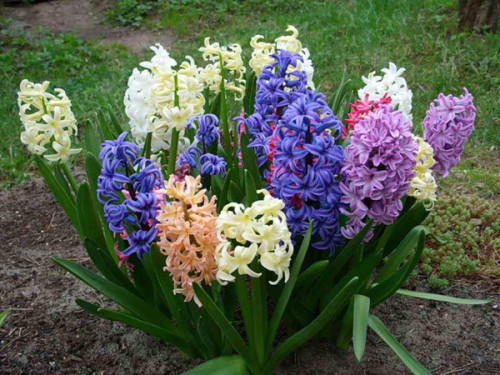

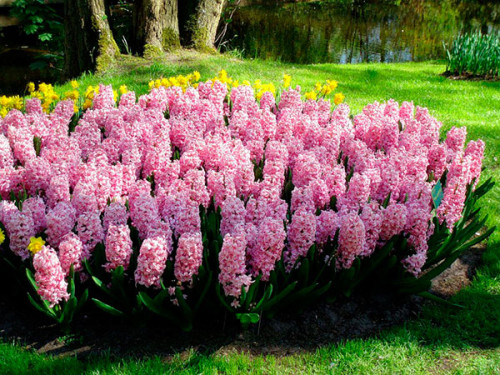
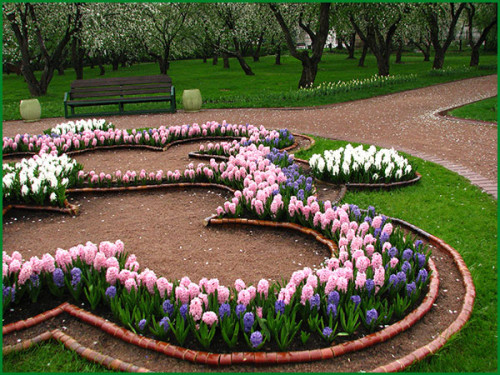












 Start a discussion ...
Start a discussion ...